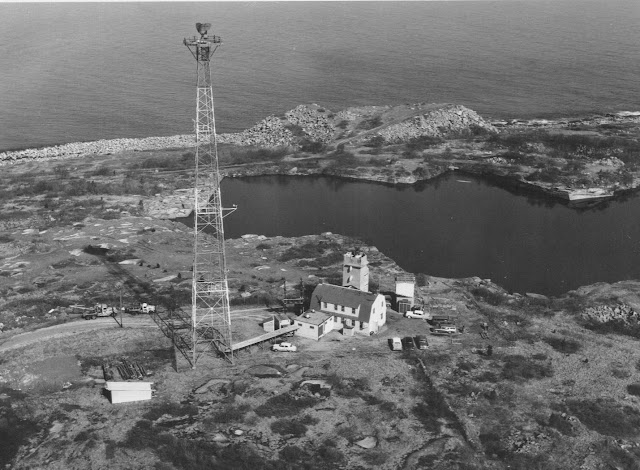By the 1930s the Rockport Granite Company had shuttered its quarrying operations and gone into receivership, attempting to sell off its barren Halibut Point property. A small part of the promontory was acquired by the federal government during World War 2 as an observation station for the defense of Boston and the Portsmouth Naval Yard.
.jpg) |
Coast Guard Tower under construction at Halibut Point, c.
1942
|
Coastguardsmen with optical devices were stationed full time in the barracks. From their elevated unobstructed tower they could look considerably further than distances comprising the horizon at sea level. The facility also contained fire control centers linked by telephone to coastal artillery batteries along the rim of Massachusetts Bay.
 |
Radar station, early 1950s
|
In the latter 1940s the United States assumed the mantle of protector of the Free World in a new global phenomenon, The Cold War. The lethal reach of military weapons extended tremendously in this competition. Radar networks became a vital part of early warning systems. The station at Halibut Point was transferred to the Department of the Air Force in 1951, closely linked to national security programs at the Massachusetts Institute of Technology Research (MITRE) and its offshoot, the Lincoln Laboratory of Bedford.
 |
The Whirlwind Computer at MIT, 1950
|
MITRE
Corporation |
Simultaneous development of the digital computer enabled high-speed processing of vast amounts of data for both civilian and military applications. By 1953 the Halibut Point installation was integrated into the regional air defense system with a role in supporting the most advanced technological research and development through MIT's Lincoln Laboratory. All operations were highly classified.
 |
165-foot transmission and receiving tower, 1958 MITRE Corporation |
Last week I received a most intriguing response to my blog posting "The Watchtower" from a fellow rambler at Halibut Point whose father was, from 1977 to 1998, the Director of Lincoln Laboratories. We met for coffee.
His father Walter Morrow was one of the youngest students ever to enter MIT at age 16, in 1945. After earning undergraduate and graduate degrees in electrical engineering he transitioned to the Lincoln Laboratory and succeeded in developing the world's first transistor radio. Communication, broadly speaking, is at the core of making information useful. A major component of the laboratory's research was in operational guidance, interfaces, and communication systems for the microwave generators underlying radar. Air traffic control and satellite navigation are two of the areas utterly reliant on those capabilities.
By geographic position and a precedent of secure military operations, as well as a small parcel under government ownership, Halibut Point was ideally suited to be a forward site of testing and deployment of the technology network. The completion of Rte 128 at this time further linked Cape Ann to Boston's technology highway. As Greg Morrow puts it, Halibut Point was the Mecca of radar and digital development. The MIT-based research teams developed the modem to compress at the sending end, then expand at the receiving end, enormous amounts of digitized information into bits that could be transmitted economically on telephone lines. This led to video broadcasting as we know it. The computer mouse was another product rooted in this 1950s era.
Practically speaking civilian and military research initiatives are almost inseparable, and their funding channels are closely entwined. A constant review of ethical directions is an ongoing part of MIT's self-examination. On its website the University applauds Walter Morrow's leadership in these matters as well as his technical innovations.
During
his tenure on the Defense Science Board, Mr. Morrow led eleven task forces and
summer studies, many of which have been used in guiding the direction of
defense acquisition and in determining critical Department of Defense
investments. He was commended for his broad understanding of national security
issues and his ability to access the best science and technical advice,
resulting in balanced and thorough recommendations.
I loved this—I’ve always been curious about that tower. Also, Walter’s son, brilliant Greg Morrow, is a beekeeper extraordinaire. But you may know that. I had no idea about his father—having focused on his bees.
ReplyDelete